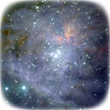
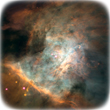
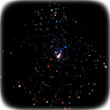
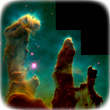
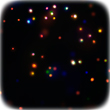
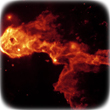
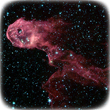
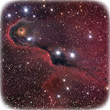
























In this image, we are looking deep into the Orion Nebula to unveil the formation process of a massive proto-star that we call Source I. Visible in this image is a region of space that's about twice the size of the solar system. Data to make this image were obtained with the VLBA—with an impressive angular resolution, if you consider that this object is fifteen hundred light years away. In the map, we do not actually see light emitted from the forming star itself (the so-called protostar), which is hiding at the center of the map and is symbolically represented by the large red circle. The reason is that the central star emits radio light that’s too dim to be detected by the VLBA. However, we can learn about the process of massive star formation by looking at its surrounding environment. The colored points of light that you see blinking in this map are emitted by the gas around the protostar. In the gas, excited silicon monoxide molecules emit maser emission, which is just the analog of laser radiation at radio wavelengths. Just like the laser used in dvd players or supermarket scanners, a maser produces a very bright, concentrated source of radio emission, that we call a maser spot. In the map, you can see hundreds of maser spots arranged in an X-shaped structure. Using VLBA, we observed the masers once per month, for nearly two years. By taking separate images and superimposing them, we created a movie of the maser emission. This allows us to track how the gas is moving and to study how it evolves with time. In this movie, maser spots are apparently moving away from the protostar along funnel-like flows, while their colors indicate whether the maser sources are moving toward us (the blue color) or away from us (the red color).